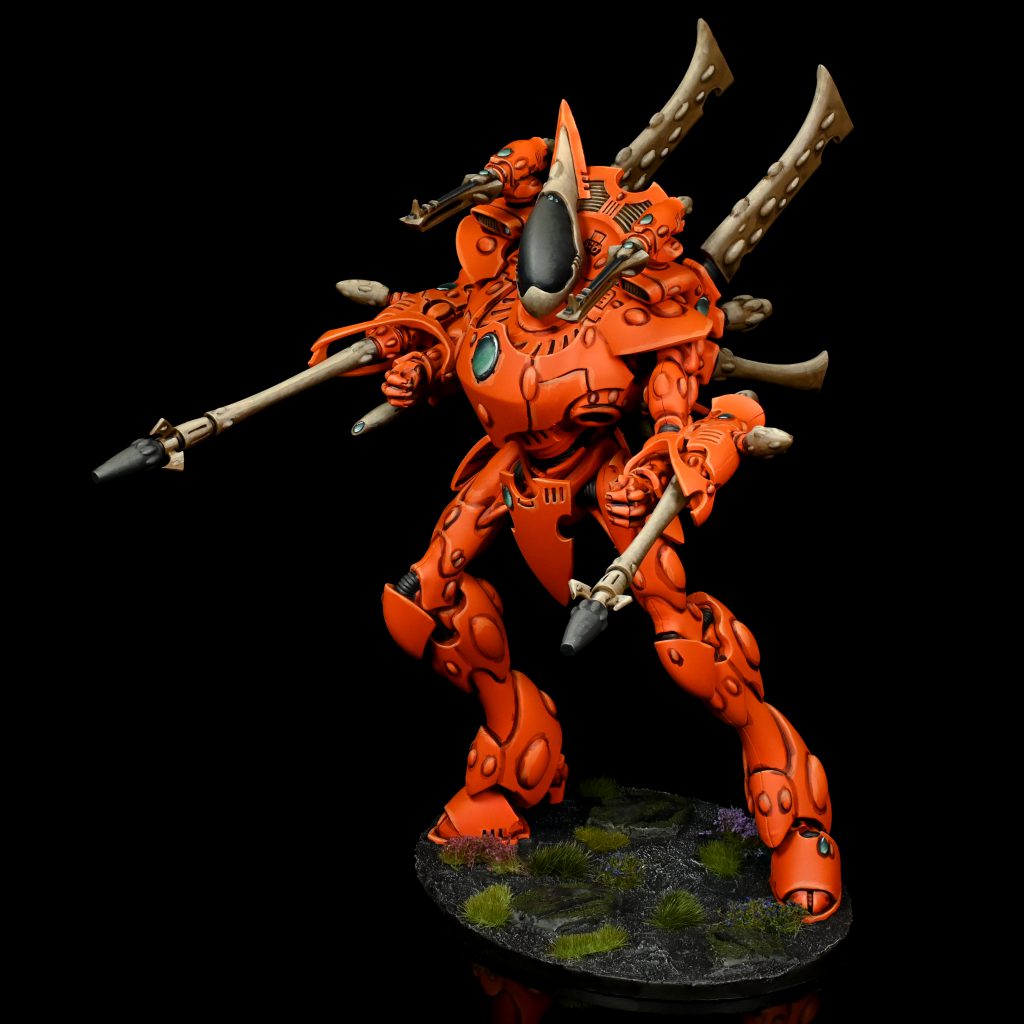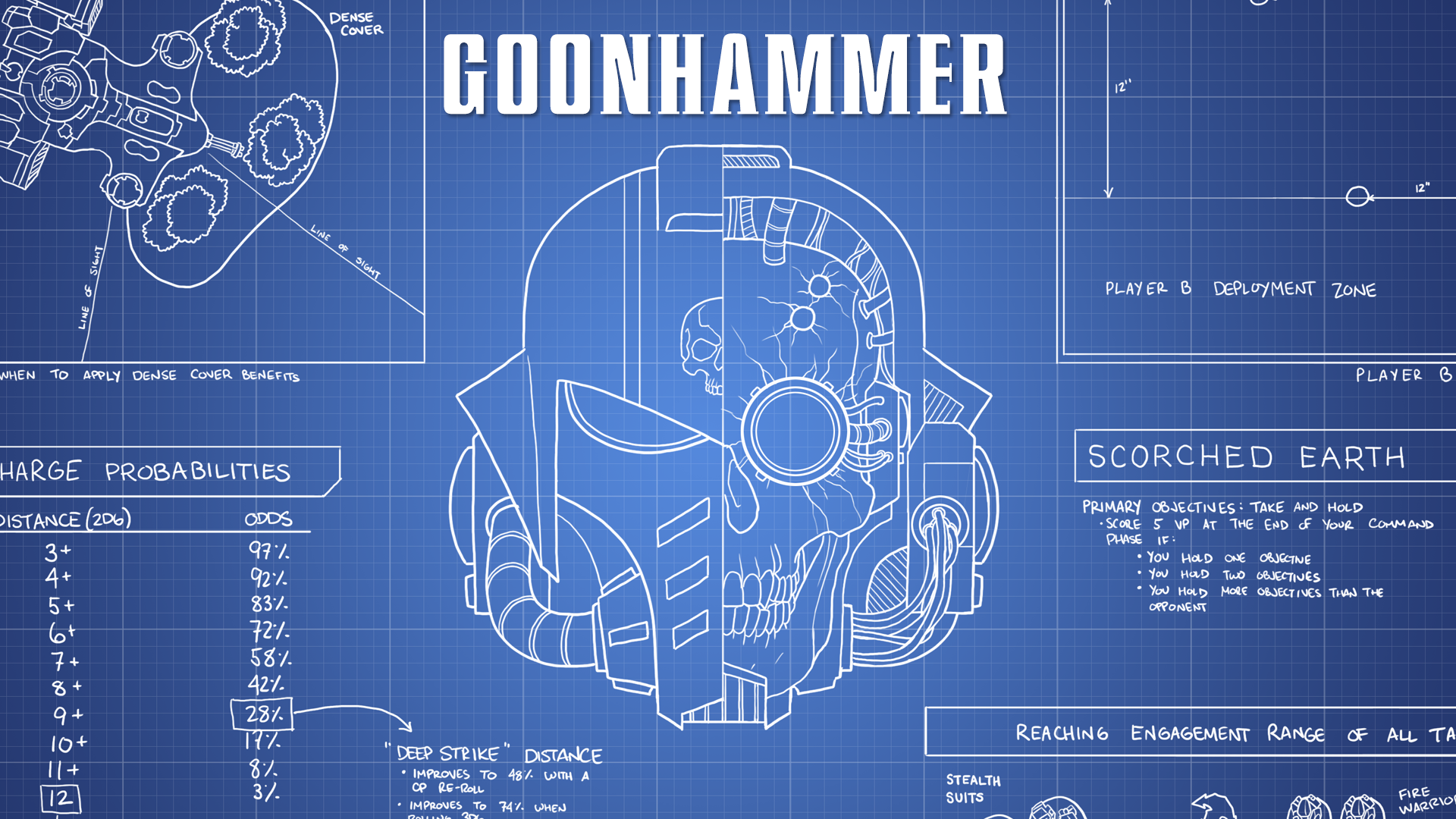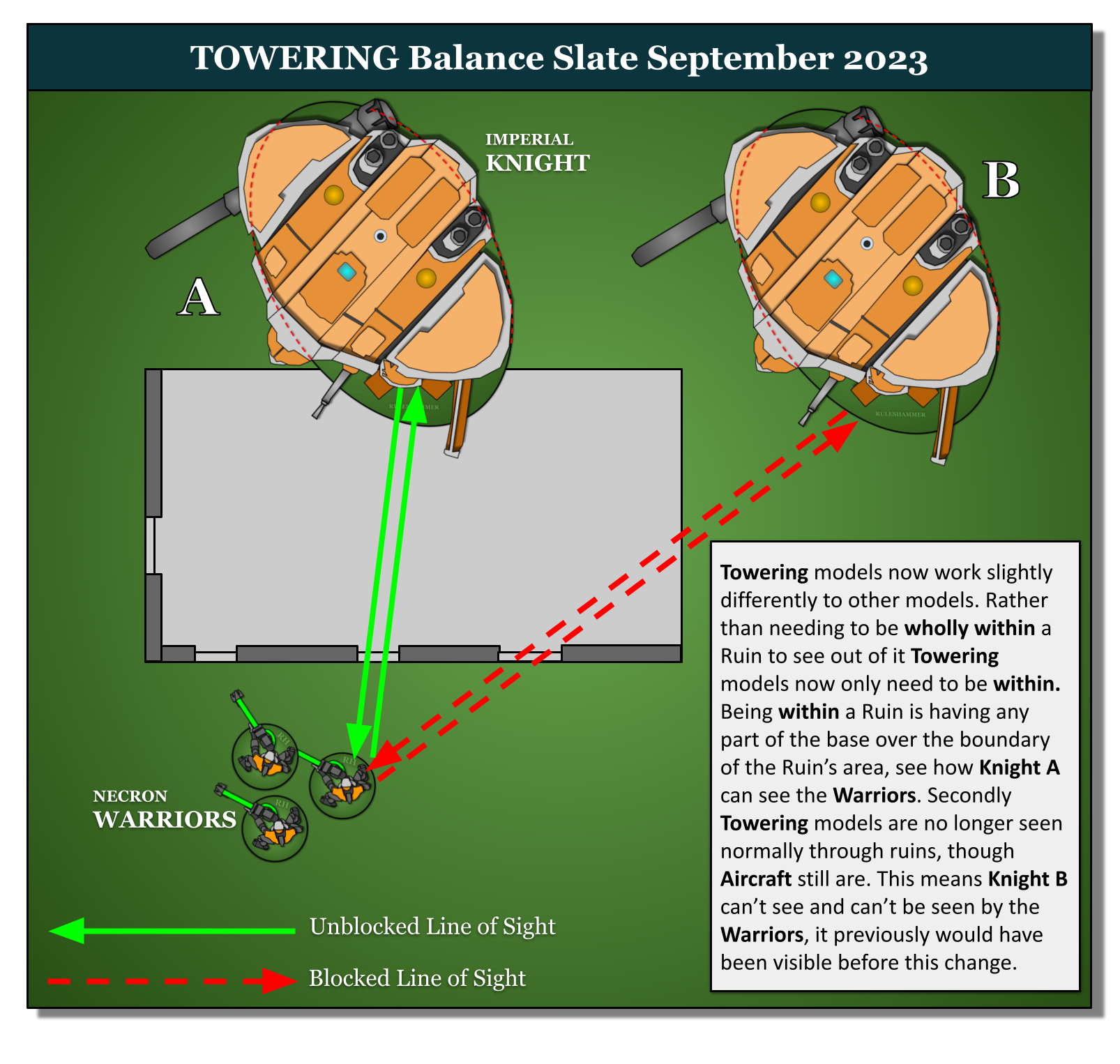The first balance dataslate of 40k’s 10th edition comes screaming down from the Games Workshop Strike Cruiser and unloads a drop pod full of rules updates, accompanied by version 1.3 of the Munitorum Field Manual which incorporates a broad sweep of points changes across all of the game’s factions. In this article, the Goonhammer team takes a look at the changes and what they mean overall. For our thoughts on how this affects individual factions, check out the Imperium, Chaos, and Xenos articles respectively.
The Balance Dataslate – Core Rules
The biggest surprise this dataslate was that Games Workshop made multiple updates to the Warhammer 40k Core Rules, making substantial changes to how the game plays. If you wanted to call this new state 10.1 edition (or even 10.5), we wouldn’t blame you.
Devastating Wounds
What Changed?
Weapons with Devastating Wounds no longer inflict Mortal Wounds instead of damage on a Critical Wound. Instead, no Saving Throws of any kind can be made against them, including Invulnerable Saves. In addition, similar to Mortal Wounds, Critical Wounds with Devastating Wounds weapons are not allocated to the target until after all other attacks the attacking unit is making are resolved.
What it Means
The big, headline change here is that Devastating Wounds can no longer “spill” damage over against multi-model targets. A big gun with this effect can still make one model really dead, but they’re no longer also great for scything through hordes. This obviously hits Aeldari the hardest, as they could use Strands of Fate to force through Critical Wounds, allowing Wraithknights and Wraithguards to obliterate almost anything. Now they can only obliterate some things. Some Imperial Knights tools also find themselves significantly toned down by this.
As far as second-order effects go, this is a knock to anything with a Feel No Pain that only works against Mortal Wounds. This is felt most keenly by the Adeptus Custodes, as Devastating Wounds are now much better against them, which combines with some other changes in this dataslate to add up to a serious knock to the faction. Less prominently, it also makes Broadsides a bit more vulnerable to these attacks, but they get a point cut to compensate.
This is a much needed change, bringing high-end Devastating Wounds weapons much more in line with other options by applying a fairly simple fix. In general, the mechanic was too much because it was used both on single-damage weapons that were meant to always threaten chip damage, and massive things like Wraithcannons, which needed quite different safety valves for balance when the effect was Mortals, but that’s much less the case with the new version. It’s also great to see that the clause about deferring resolution of Devastating attacks to the end has been included, because one of the good things about consolidating lots of different things under Devastating Wounds was that it substantially reduced the number of situations where you needed to slow-roll attacks because the order mattered. Keeping that means that this is solidly the best of both worlds (admittedly unless you’re a Custodes player).

Free Stratagem Effects
What Changed?
Certain effects can now only be used on Battle Tactic Stratagems. Those effects are ones that:
- Modify the CP cost of a Stratagem.
- Allow a Stratagem to be used on a unit even if it has already been used by another unit.
The exceptions to this rule are effects that specifically name a Stratagem (such as the Hexmark Destroyer’s ability to use Overwatch for free). In addition, Stratagems that target multiple units can only be affected by cost modifications that apply when you target a specific unit if all the targeted units have that effect.
Finally, the following Stratagems are no longer Battle Tactics:
- Custodes – Unwavering Sentinels (Fight First on an Objective)
- Grey Knights – Haloed in Soulfire (Untargetable outside 12”)
- Imperial Knights – Thunderstomp (Devastating Wounds against small targets)
What it Means
Massive amounts. Free/repeating Stratagem effects have been an interesting and exciting addition to 10th Edition, but have proven to be too strong in a number of ways, resulting in the units that provide them being effectively auto-takes in many lists, and seriously constraining angles of attack against some armies. This was particularly acute with 2CP Stratagems such as Unwavering Sentinels, which Custodes could threaten at all times, making it near impossible to interact with them in melee on an objective. On the flip side, units that provided access to a “Vect” effect to increase enemy Stratagem costs were incredibly good, but it was kind of luck of the draw whether a faction had access to a good way of including one in lists (except for Imperium, who pretty much always could thanks to the Callidus Assassin).
Alongside that, the once-per-phase limitation on Stratagems exists for a reason. Most of these effects would have been good enough if they just gave you a free Stratagem, but letting you double up as well could lead to some very unfun interactions like Necrons Reanimating multiple units in a phase, double Overwatch to punish enemy movement, or double Grenades to deal unhealthy numbers of Mortal Wounds.
The scope of all of these effects narrows considerably, and the designers now have agency to decide whether or not they want a given Stratagem to be in-scope for modification (which they’ve already started to use). Neither reductions for you nor penalties for the opponent become bad per-se, but they’re also no longer auto-takes in any list that can have them. It is worth flagging that the Command Re-roll stratagem is a Battle Tactic, so you’ll almost always have something you can do with them, but it’s no longer going to be a big swing day in, day out. The Callidus Assassin has, of course, gone down in points alongside this, so she’ll probably still be in lots of lists, but other options maybe not so much.
Conversely, units that just flat give you an extra Command Point each turn go up in value after this, as if you want to be spending big on 2CP Stratagems, they’re now your most reliable route. Expect to see a significant pivot towards these, especially any that went down in price.
While we do think this will have an overall positive impact on the game, we don’t love the implementation here, because it’s going to feel a little arbitrary to some players, and hits quite unevenly – Thousand Sons and Genestealer Cults are affected particularly badly, and while the snap reaction to that might be “good”, it’s hitting alongside a lot of points changes. Once the new paradigm has had time to bed in, and there have maybe been a few more adjustments to stratagem types to account for it, it’ll likely be fine, but some exploration of other options might have been beneficial. We also hate that Stratagems are colour-coded in 10th – but not by category, instead by which turns they can be used in. Hopefully the App will be updated with a second bit of colour-coding now that this matters way more.
Overwatch
What Changed?
Above and beyond the changes above, Overwatch now has two new restrictions:
- The target has to be visible, so no more Indirect overwatch.
- TITANIC units can’t use it at all.
What it Means
Like some other mechanics in 10th, Overwatch does plenty of cool things, but was unfun in a few places. Notably, using it with D-cannons or Sustained Hits Desolation Marines from behind walls was soul-crushing to play against, and on some TITANIC units (particularly those with access to full re-rolls or Sustained Hits) it was too effective, making it very hard to counter them. Both of these problems are now removed wholesale. That’s obviously bad for Aeldari, Knights, Marines and maybe Guard, and good for pretty much everyone else. We do feel that this might end up being too harsh on Knights, because while it was exceptionally strong for them, it’s counterbalanced by them having fewer units on the board. We wouldn’t be surprised to see a later tweak to allow those armies specifically to use this on TITANIC stuff for 2CP instead of not being allowed to at all.

Insane Bravery
What Changed?
Insane Bravery is substantially weakened – it now has to be used before rolling a Battle Shock test, and can only be used once-per-game.
What it Means
Battle-shock just wasn’t mattering quite enough as it was, because failing a test in your Command Phase could be so trivially mitigated when it really mattered. Now it’s an actual choice and limited, so good news for factions that can force additional Command Phase Battle-shock tests like Chaos Knights and Tyranids.
This is a good change, but for Battle-shock to really matter, we think some changes to the rule itself will be needed. Specifically, stuff that inflicts Battle-shock “out-of-sequence” could do with a boost (perhaps forcing a unit affected to re-test in their next Command Phase even if above Half-Strength), and the definition of “Below Half-strength” probably needs to change to “equal or below” so that units with a Starting Strength of 2 (like many units of light Vehicles/Monsters) aren’t completely immune to it.
Towering and Ruins
What Changed?
TOWERING units no longer completely ignore Ruins for visibility purposes (in both directions). Instead, such units can both see and be seen through the ruin as long as they are partially within it (often referred to as “toeing-in”).
What it Means
A huge amount. Some TOs have already run events with variants of this house-ruled in, and this has been a popular suggestion throughout the community for how to “fix” Towering, and it’s generally the one our team have been biggest fans of. Towering seems to exist to address the problem that in 9th Edition, it could end up very hard for Lords of War to interact with the enemy – they could be shot at, but not shoot. In theory, Towering established parity between attacker and defender. In practice, Lords of War tend to be very tough and heavily armed, meaning a gunfight with them where you can’t hide is often one you’d lose. It also put a huge amount of weight on the first turn roll-off when Towering armies faced off against others with very strong shooting, as the first Shooting Phase could decide the game. Non-games suck for everyone involved, and the rule was also making it very difficult for GW to properly balance units that had it. To a lesser extent, Towering was also necessary to handle the fact that Ruins now normally require you to be wholly within them to see through, which a Knight base basically never will be.
This fix retains the parity of the original Towering rule (if you can see them, they can still see you), but makes it possible to pick your battles against models that have it, and sorts out the ruin interaction. It also means that Knight armies can now actually hide their big stuff when they need to, which is especially good news for Chaos Knights, as it’s now safer to build around the auras that their big units hand out. Big thumbs up from us here, zero complaints.
Rules Commentary Changes
Along with the balance dataslate and points updates today, Games Workshop dropped two rules commentary changes we weren’t expecting and which are now live in the app. Here’s the rundown of what changed and what it means:
- Eligibility to Shoot. Units are now clearly defined as no longer being eligible to shoot during a phase if they’ve already shot. This clears up some confusion around things like For the Greater Good, which under some interpretations could lead to “daisy-chaining” activations. This also means that if you want to use Stratagems like Grenade, you absolutely need to pick a unit which hasn’t shot yet, so make sure you have the right order for those.
- Vehicle bases. One of the most contentious/confusing parts of 10th editionrules was how to handle “hovering” units, i.e. units with models that overhang their bases by a considerable amount, such as Hammerheads or Repulsors. To handle these the rules now have you always measure to and from the closest part of the base or hull, whichever is closest. Additionally models are now considered to be in base-to-base contact with those vehicles if they’re “under” them, i.e. within 0″ horizontally and 5″ vertically of them.
Overall Impacts
The Core Rule changes in this update are very good overall, and make 10th Edition a better game in a lot of ways. We’re really, really happy to see GW being willing to make this magnitude of update to address some of the teething problems that 10th has encountered, and while plenty of us have already been having a lot of fun with it, we’re even more excited going forward. We also think that the choice to make rules and points changes in parallel, with some clear places where the interactions between the two have been carefully considered, was a very strong one, and increases the quality of the overall update.
In terms of individual factions, which we’re going to dive into in separate articles, we’re pretty happy with the overall direction that most factions have been shifted, but inevitably there are places where we’d quibble with the exact decisions made and a couple of truly baffling choices that will take a few units wholly out of the game till the next update. If anyone knows what the Tyrannofex did to the rules team, let us know.
Top factions generally get hit substantially, and the identification of which ones those are is largely correct, but we’re concerned that Aeldari may not have taken quite enough of a knock, and Necrons probably needed to get hit slightly harder than they were. That combined with boosts elsewhere might end up with Thousand Sons, GSC, Imperial Knights, Deathwatch and Custodes dropping a bit further than was probably needed in the overall pecking order. At the other end of the spectrum, Votann, Death Guard, Sisters and Tau get the help they need (maybe, whisper it, too much in some cases), but AdMech get a far lighter touch despite struggling just as hard, and that’s particularly galling given Marines get quite a lot of help too. It’s also surprising to see Tyranids take some nerfs before their codex has even been fully unleashed, but other than the poor Tyrannofex, they’re probably not unreasonable given access to a new book and how everything else has shifted (and they do get some buffs as well).
Overall? We’re glad to see Games Workshop really willing to go at this, and we think when read as a whole, this looks like a pretty strong attempt. Straw polling amidst our review team has us rating it between 7-8.5/10 depending on how grouchy or optimistic a given respondent is, and that’s pretty damn good. Certainly, pretty much every one of us is more excited to play 10th Edition going forward, and that’s the key benchmark here.
That’s it for the balance dataslate – don’t forget to check out the Imperium, Chaos, and Xenos articles, and as ever if you have any comments or feedback then join in the discussion below or e-mail as at contact@goonhammer.com.



